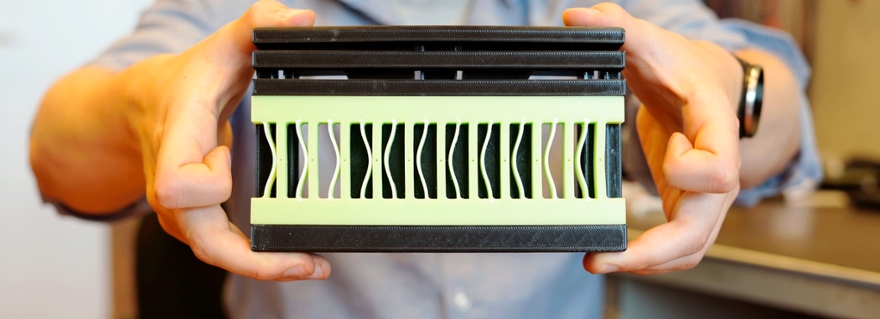If you’ve ever called someone “dumb as a block of rubber,” you may wish to upgrade your insults, because it turns out a lump of rubber with some holes punched in it can count. It doesn’t even need fingers and toes. If this sounds like a remarkable, but useless, achievement, the designers think it might have applications in fields such as bridge engineering. More broadly, it shows inanimate objects don’t always need sophisticated circuit boards to perform mathematical feats.
Some materials contain a memory, returning to their previous shape when conditions such as temperature change, a feature that has proven useful in satellite deployment. In Physical Review Letters, a more impressive feat has been revealed, with a piece of rubber of just the right flexibility that can count simply by being carved into a ceiling, floor, and pairs of beams.
Universiteit Leiden PhD student Lennard Kwakernaak calls it a “beam counter”, and it can be operated just by squeezing. “I like finding complexity in simple things,” he said in a statement. Although the first prototype of his counter has 22 beams, giving it the capacity to count to 10, the size could be adjusted to fit the maximum number required. Perhaps more impressively, it’s easy to expand to something that can differentiate between soft and hard pressure, recording each separately.

The block of rubber counting to three.
Image Credit: Leiden University
When pressure is placed on the top of the counter, the beams bend left, other than the first, which is engineered to bend the other way. In doing so, it bulges to apply pressure to the next beam, setting it up so that after the next push the second will also bend right, and extending the sequence. Crucially, the rubber is stiff enough that it does not bend back afterward. Instead, it maintains a record of how many times it has been pushed, ready for the next addition.
The paper notes that even Venus flytraps can count. Their capacity stops at five, however. This piece of rubber has the potential to go much further.
The beams become the equivalent of computer bits, storing either ones or zeros. “Counting is the simplest computation we could come up with, so that was the logical starting point,” Kwakernaak said. He’s also built a version with two separated divisions, one of which counts heavy pressures, the other counting light ones. These could be used as the equivalents of tens and ones, potentially opening the way to devices that can count to much larger numbers.
Kwakernaak’s creation forms a metamaterial, something simple with a property seldom or never observed in nature. “I found out that you can cause different reactions in the rubber by pushing with different levels of force,” Kwakernaak said. “By experimenting with this, I was able to make a metamaterial that only counts to the end if you push on it in the right order, with the right amount of force. A kind of lock, in other words.”
In the days when an abacus was the most advanced form of calculating technology available, Kwakernaak’s creation might have launched an industrial revolution. In an age of computers it’s less clear if there is a niche, despite its elegance and capacity to operate without electricity.
Nevertheless, Kwakernaak notes any products would be; “Cheap, robust and low-maintenance. That makes them interesting for all kinds of applications. It’s hard to say exactly what those will be, but we always find a purpose for new materials like this.”
The study is published in Physical Review Letters.
Source Link: Physicists Made A Block Of Rubber That Can Count To 10